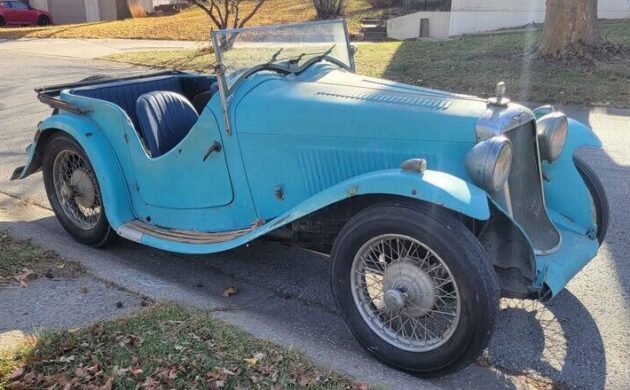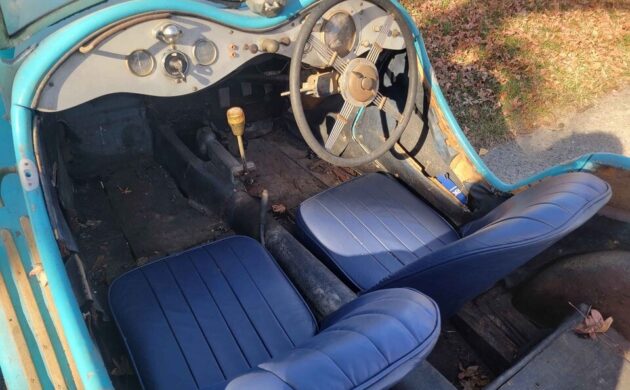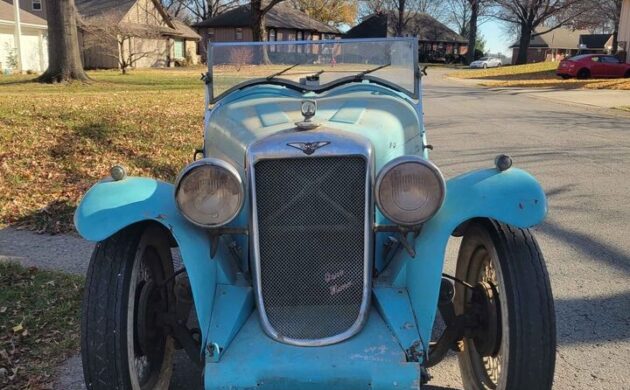In December of last year, Barn Finds author Jim O’Donnell covered this right-hand drive 1935 Hillman Aero Minx, then priced at $18,500. Maybe two times is the charm because here she is again on Facebook Marketplace, but now on sale for $15,000. This car is located in Kansas City, Missouri. Hillman started, like countless British automakers, making bicycles. By 1932 it was producing its first cars, capturing a niche in the 10hp tax bracket (Britain’s weird way of charging for auto licenses) that gave families a bit more comfort and style. Soon, the company aspired to the sports car market, introducing the Aero Minx in 1933. This line of cars included three saloons, but also a tourer, as well as a selection of special coach-built bodies. We are likely looking at a tourer here. T.J., thank you once again for this fine tip!
The motor was a slightly warmed-up version of Hillman’s 1185 cc in-line four-cylinder, good for about 30 bhp and a top speed of around 65 mph. A higher compression ratio, a single 1 1/2″ downdraft SU carburetor, stronger valve springs, and a sportier axle ratio helped the car appeal to time trial and hill climb drivers. An aluminum cylinder head was available but it’s unclear if that was an option or if every Aero Minx was so equipped. The remote gearbox was a four-speed manual and in 1935, this became all-synchromesh, allowing Hillman to claim the first all-synchro transmission on a production car. (This treasured feature was discontinued for cost reasons in 1939.) The seller indicates his car starts up immediately and does not run hot.
The interior shows the afterthought of a rear seat, barely more than a parcel shelf, and the gearshift, which is connected to the transmission using a series of levers. The soft top is missing and this car would have come with side curtains – the seller is mum on that score. He does indicate that the car has aluminum body panels and steel fenders. The use of aluminum would have been unusual, though Hillman did provide cars to a variety of coachbuilders in England. Note the asymmetrical cut in the doors: the driver’s side is deep for that rakish look.
The grille badge belongs in the upper left. The knurled nuts on the sides of the windshield are a hinge point for folding the windshield down against the double-bubbled cowl. Pre-war sports cars offer a challenging but fun experience to the collector. Challenges arrive when the gearbox won’t shift any longer, or the number two cylinder loses compression on a car of which only 650 copies were made. On the other hand, topless cars that can’t go very fast and look this sporty are a blast to drive. The price is becoming more reasonable here, but I’m thinking it might have to undergo a further reduction; what do you think?






Man, how cool to come across this gem here in the states in the 1930s! The hot rodder Would have been scheming a weekend Ford flathead V-8 swap one day after purchase!
One of my earliest memories as a small child, is a Hillman wagon my parents had, probably from the ’50’s. I think it was also called a ‘Minx’, very small- memories of a handle behind the front seats that opened the back.
Much less crude than the car pictured here, but nice to learn something about the company- terrific write-up Michelle!
Hi Michelle, “The gearshift, which is connected to the transmission using a series of levers”. I think the accurate description is that it is known as a REMOTE gear shift.
That is right. I mention that in the second paragraph.
Correct, I’m so sorry, I must have been reading the article too fast. Great write up.
I think this is a March bodied car. The company was run by Freddie March, later Duke of Richmond and the owner of Goodwood House, founder of Goodwood race track.
If so, someone just go and pay the man his $15K because its provenance is worth far more and the restoration is easy.
This one would be a blast to own and drive, but the price is too steep for an MG Clone type car.
Thought I posted this earlier, but it doesn´t show.
This looks to be a March body, which is the short-lived but highly respected and collectible coachbuilder founded by Freddie March. The Hon Freddie became the Duke of Richmond, owner of Goodwood House and built the motor racing cicuit which hosts the Goodwood Revival to this day, in the hands of his grandson.
This car is good value, it would be an easy restoration and a good investment, but you´d need to understand provenance and history to appreciate its potential.
I don’t think this is a March body. I looked those up and they appeared to be very short coupled, with virtually no rear seat. I could be wrong, but here’s what I am seeing.
https://www.brooklandsmuseum.com/explore/heritage-and-collection/our-collection/hillman-aero-minx-streamliner
Downdraught SU carby, I don’t think so.
Just to set straight the historical record, the first car with the Hillman name appeared long before 1932. William Hillman did indeed start with bicycles, but he went on to partner with French designer/engineer Louis Coatelen and in 1907 they produced the Coatelen-Hillman. About a year later Coatelen sold his shares in the company to Hillman and thereafter the cars were branded Hillman. In 1928 the Hillman Motor Car Company Ltd. merged with Humber Ltd — coincidentally the two factories were side-by-side in the Stoke suburb of Coventry – and very soon after that the Rootes brothers bought control of the merged company. The 1932 date is significant in Hillman history — that was when Rootes announced a new 10hp car, the Hillman Minx. The Minx name was to survive, over generations, through to the later 1960’s Hunter range and the take-over of Rootes by Chrysler.